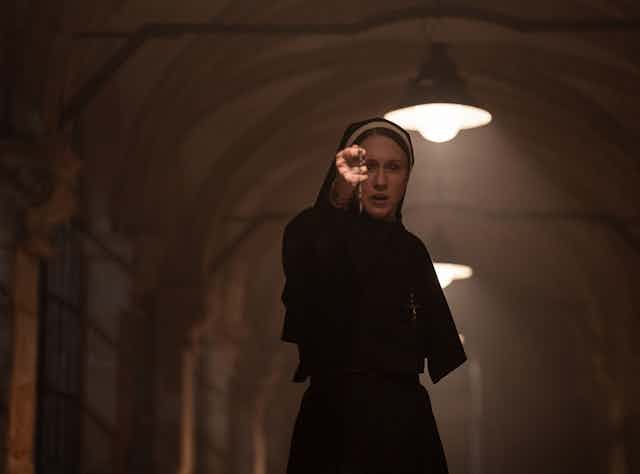Warning: contains minor spoilers for The Nun II.
The Nun II is an arresting piece of storytelling which satisfies and subverts audience expectations in equal measure. On one level, it is an extremely watchable piece of action horror, comfortably divorced from reality. The demon from the previous film has resurfaced and is now stalking a group of thoroughly-likeable characters in a French boarding school.
Sister Irene (Taissa Farmiga), the eponymous nun who previously defeated the demon, has been called in once again by the church authorities. She is assisted by Sister Debra (Storm Reid), a novice who doubts her own faith. This premise makes for a classic battle between good and evil. And there’s a steady stream of scares as the tension builds, before exploding into a jump-out-of-your seat moment.
Those familiar with the real Catholic church will recognise that exorcisms, the sacraments, saints, holy relics and the respective roles of nuns and priests are not depicted with realism in The Nun II. And there is a casual side-stepping of the all-too-real gender constraints of the mid-20th century.
However, the Nun II does bring a refreshingly feminist gloss to well-worn tropes within exorcism fiction, shattering assumptions about who should be the victim and who should be the rescuer.
Subverting the demonic
In popular culture, the stereotypical possessed person is female and, frequently, a child. The seismic impact of the character of Regan in The Exorcist (1973) is undeniably one factor in this. But the idea has deep and ancient roots.
Research has demonstrated that possession and demonic attacks tend to be associated with women and girls, both in historical and contemporary Christian cultures. There are a variety of reasons for this.
In the middle ages and early modern era, women were seen as more carnal, less spiritual and weaker than men in both moral and intellectual terms. It was believed that this rendered them easier pickings for the devil. This thinking tied in with the biblical narrative that the serpent in the Garden of Eden deceived Eve rather than Adam. Of course, the point that Adam was feeble enough to take the fruit from his wife, despite God’s instruction, was either brushed under the carpet or used to further evidence the dangerous and malign female influence.

The vast majority of victims of harm linked to exorcism are female and in many cases the assailants are family members. Exorcism abuse is commonly a form a domestic abuse. In 2009, Janet Moses, a young woman from New Zealand, was killed by her relatives in the course of rites to free her from evil spirits. This tragic story formed the basis of a 2015 film: Belief: The Possession of Janet Moses. In England in 2021, a doctor was jailed for having illegally administered dangerous drugs to his partner in connection with exorcism rituals.
The Nun II’s innovation
Women – and especially adolescent girls – are usually imagined as prey when it comes to demonic forces. This perception shapes both real-world behaviour and the entertainment industry. Consequently, The Nun II, in which all of the key demon-battling protagonists are female and coming to the rescue of a stricken adult man, is a dramatic inversion of the norm.
Furthermore, none of the women are infantilised or sexually objectified. They kick and batter monsters in long skirts, trousers, knitted jumpers and sensible shoes. Even the children are given more fighting to do than squealing (although some screaming is allowed and, frankly, understandable if you are being pursued by the literal devil incarnate).

All of this progressive change takes place without either ridiculing the men or turning them into pantomime villains. The female actors are allowed to be the rescuers due to the situation, rather than because of any inadequacy on the part of their male companions.
The film’s depiction of church dogma and ecclesiology belongs to Hollywood rather than Rome, and nobody should watch it imagining they will be enlightened about Catholic teaching on demons or other subjects (indeed, there are certain misrepresentations in this regard which some believers might find troubling).
Nonetheless, given the damage done to women and girls through exorcism-related abuse (most of which takes place outside Roman Catholic settings) and harmful gender stereotyping more generally, a film that breaks this mould has a lot to commend it.

Looking for something good? Cut through the noise with a carefully curated selection of the latest releases, live events and exhibitions, straight to your inbox every fortnight, on Fridays. Sign up here.

